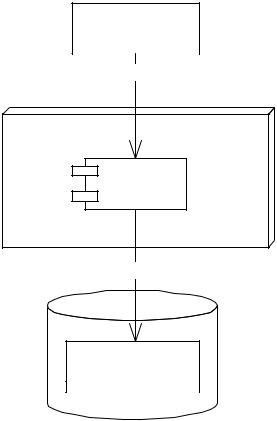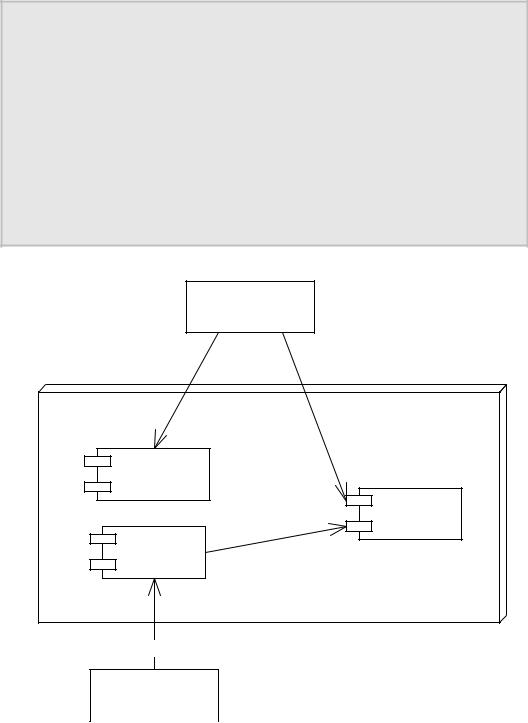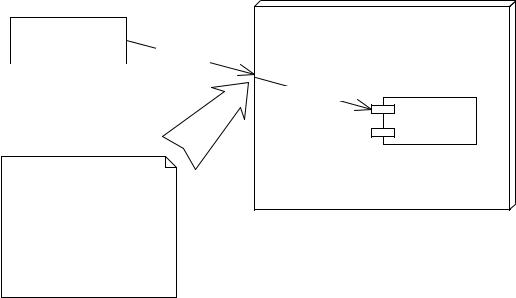
Mastering Enterprise JavaBeans™ and the Java 2 Platform, Enterprise Edition - Roman E
..pdf
Enterprise JavaBeans Overview |
|
55 |
account balance. Thus, entity beans allow you to combine the functionality of persistent data with the convenience of object encapsulation. In essence, an entity bean implements the data access logic layer in multi-tier architectures. This is shown in Figure 2.3.
Because they model permanent data, entity beans are long lasting. They survive critical failures, such as application servers crashing, because entity beans are just representations of data in a permanent, fault-tolerant underlying storage. If a machine crashes, the entity bean can be reconstructed in memory again by simply reading the data back in from the permanent database. Because the database survives crashes, the components that represent them do as well. This is a huge difference between session and entity beans—entity beans have a life cycle much longer than a client’s session, perhaps years long, depending on how long the data sits in the database.
Client Code, such as servlets or
applets
<<invokes>>
EJB Container/Server
Entity Bean
<< save and load when necessary >>
Bank Account #
Owner's Name
Account Balance
Permament Storage
Figure 2.3 Entity beans are a view into an underlying data store.
Go back to the first page for a quick link to buy this book online!

56 |
|
M A S T E R I N G E N T E R P R I S E J A V A B E A N S |
EJB Design Strategies
Session Beans versus Entity Beans
Now that you’ve seen the different types of enterprise beans, how do you decide what logic to put in a session bean and what to put in an entity bean? The key differences between the two are that session beans represent business processes and typically contain business logic, and entity beans, on the other hand, embody permanent business entities, such as business data, and typically contain data-related logic.
As a concrete example of this, consider an application that is responsible for generating prices of products for customers. If a customer wants to order 15 workstations, with a certain bundle of memory and processors, the pricer would display a price detailing the products and listing the price of each item.
A pricer component is well represented by a session bean: The pricer is having a business process conversation with the client. The client code interacts with the pricer, asking for prices of products that the customer has indicated, and then the client code disconnects from the pricer component. After the conversation is over, the pricer is free to service another client.
Later, when the customer wants to place an order, an order entity bean could represent the customer’s permanent request for goods to be delivered. The order bean would represent database data that detailed the customer’s purchase. The order can then be fulfilled by another application—perhaps another session bean that contains the logic to do so. This is shown in Figure 2.4.
Notice the theme here: Session beans are performing application logic, which uses persistent entity beans behind the scenes as the data that they’re manipulating. This is very similar to the façade design pattern. A façade is a high-level interface that masks lower-level subsystems. In the EJB distributed object architecture, session beans can be used to provide a high-level interface façade to business processes, masking the lowerlevel entity bean subsystems used behind the scenes.
Because entity beans model permanent business entities, entity beans typically achieve a higher level of reuse than session beans. For instance, consider our banking example, with a session bean that acts as a bank teller. This session bean knows how to withdraw and deposit by calling methods on a bank account entity bean. One day, you may decide to replace your session bean teller with a different teller bean. But you’d still want all your customers’ bank accounts to remain the same.
Now consider our order-entry example. Here, your company’s product line, as well as the purchase orders themselves, are data. Therefore, they are well represented as entity beans—objects that are saved over time and are forever part of the database. The components that generate and manipulate the products and the purchase orders are very well modeled as session beans. You’d probably want to fine-tune and change these session beans over time, as user requirements change.
Thus, in practice you can expect the reuse of session beans to be a bit lower than that of entity beans. Session beans model a current business process, which can be
Go back to the first page for a quick link to buy this book online!

Enterprise JavaBeans Overview |
|
57 |
tweaked and tuned with different algorithms and approaches. Entity beans, on the other hand, define your core business. Data such as purchase orders, customers, and bank accounts do not change very much over time, and in practice entity beans achieve a higher level of reuse.
Note that what we’ve presented here are merely guidelines, not hard-and-fast rules. Indeed, a session bean can contain data-related logic as well, such as a session bean performing a bulk database read via JDBC or SQL/J. The key to remember is that session beans never embody permanent data, but merely provide access to data. Session beans are not persistable; they represent business processes. By comparison, entity beans embody data and are persistable. If you have a business process that you’d like to run in a transactional, distributed, and secure environment, you can use session beans to model that business process. If you have a permanent business entity, you can access that entity as a distributed component by representing it as an entity bean.
Client Code, such as servlets or
applets
1: call price() |
|
2: create Order |
EJB Container/Server |
|
|
|
|
|
|||
|
|
|
Pricer Session
Bean
Order Entity
Bean
Fulfillment |
|
Session |
|
Bean |
4: Fulfillment Bean analyzes the generated Order |
3: Later on, a separate application fulfills the Order
Fulfillment
Application
Figure 2.4 Combinations of beans in a pricing application.
Go back to the first page for a quick link to buy this book online!
58 |
|
M A S T E R I N G E N T E R P R I S E J A V A B E A N S |
Entity beans are distinct from session beans in another respect as well—mul- tiple clients can use entity beans simultaneously. Think of this as multiple clients manipulating the same data in a database simultaneously. You can isolate these clients from one another by using transactions. When used properly, transactions guarantee that multiple clients who perform persistent operations act completely independently of one another. We’ll find out more about transactions in Chapter 10.
Entity beans are very useful when you have a legacy database with data already inside. They are great for providing access to existing persistent data. In this manner, the data that entity beans model could exist in a database before a company decided to employ Enterprise JavaBeans.
In fact, the database records representing an object could have existed before the company even decided to go with a Java-based solution because a database structure can be language-independent. Database records can be read in and interpreted as objects in almost any language. EJB takes advantage of this and allows for the transformation of a database’s data into a Java object. The burden of this transformation can fall on the bean itself or the EJB container can perform the transformation automatically.
This brings us to the next topic. There are two subtypes of entity beans available: bean-managed persistent entity beans and container-managed persistent entity beans.
Bean-Managed Persistent Entity Beans
As we have seen, entity beans are persistent components because their state is saved to a secondary storage such as a relational database. For example, by using object-relational mapping technology, you can take an in-memory object and map that object into a persistent series of relational database records. You can then retrieve those records at a later time to reconstruct the object in-memory and use it again. Another scheme is to use an object database as your persistent store, which stores actual objects rather than relational records.
A bean-managed persistent entity bean is an entity bean that must be persisted by hand. In other words, you as the component developer must write code to translate your in-memory fields into an underlying data store, such as a relational database or an object database. You handle the persistent operations yourself— including saving, loading, and finding data—within the entity bean. Therefore, you must write to a persistence API, such as JDBC or SQL/J.
Container-Managed Persistent Entity Beans
The good news is that EJB allows entity bean developers to not worry about coding persistence logic. One service that EJB 1.0 containers may provide, and EJB 1.1 containers must provide, is automatic persistence for your entity beans.
Go back to the first page for a quick link to buy this book online!

Enterprise JavaBeans Overview |
|
59 |
The container/server performs every function of your component’s data access layer for you, including saving, loading, and finding component data. You do not have to hard-code to a relational database API or an object database API, saving much coding time. Rather, you simply describe what you want persisted upfront to the container, and it persists it for you, using whatever storage it happens to have. This gives you theoretical database independence, allowing you to switch one data store for another, since you don’t write any code to a database API. The EJB container/servers on the market today perform a wide variety of mapping functionality and tools—some simple, some complex. For example, BEA’s WebLogic server performs fairly simple object/relational mapping. But BEA also supports the Object People’s TOPLink, an enhanced persistence module that allows for complex mapping.
When choosing between container-managed persistence and bean-managed persistence, many issues are at stake. We’ll contrast the promises and realities of automatic persistence fully in Part II.
Motivation for Multiple Bean Types
You may be wondering why the EJB paradigm is so robust in offering the various kinds of beans. Why couldn’t Sun come up with a simpler model? Microsoft’s N-tier vision, for example, does not include the equivalent of entity beans—com- ponents that represent data in a permanent storage.
The answer is that Sun is not the only company involved in constructing the Enterprise JavaBeans standard. In fact, many companies have been involved, each with customers that have different kinds of distributed systems. To accommodate the needs of different enterprise applications, Sun decided to allow users the flexibility of each kind of bean.
Admittedly, this increases the ramp-up time to learn EJB. But it also pays off in the long run with increased functionality. By including session beans, Sun has provided a mechanism to model business processes without writing middleware in a distributed multi-tier environment. By including entity beans in the EJB specification, Sun has taken the first steps toward persistent, distributed objects usable by those business processes.
Overview of EJB Container and EJB Server
Responsibilities
Earlier in this chapter, we mentioned that EJB containers provide the implicit services to your EJB components and that containers live within the runtime environment of an EJB server. Because the EJB specification has not drawn the
Go back to the first page for a quick link to buy this book online!

60 |
|
M A S T E R I N G E N T E R P R I S E J A V A B E A N S |
Single-Threaded versus Multithreaded Session Beans
One great benefit of EJB is you don’t need to write thread-safe code. You design your enterprise beans as single-threaded components, and you never need to worry about thread synchronization when concurrent clients access your component. Your EJB container will automatically instantiate multiple instances of your component to service concurrent client requests.
The container’s thread services can be both a benefit and a restriction. The benefit is that you don’t need to worry about race conditions or deadlock in your application code. The restriction is that some problems lend themselves very well to multithreaded programming, and that class of problems cannot be easily solved in an EJB environment.
So why doesn’t the EJB specification allow for multithreaded beans? The answer is that EJB is intended to relieve component developers from worrying about threads or thread synchronization. The EJB container handles those issues for you by load-balancing client requests to multiple instances of a single-threaded component. An EJB server provides a highly scalable environment for single-threaded components, and adding the abillity for beans to control threads opens up a Pandora’s box of problems. For example, the ability for an EJB container to control a transaction (discussed in Chapter 10) becomes a very complicated problem if threads are being started and stopped randomly by beans.
One alternative to threading is to use a transactional messaging API such as the Java Messaging Service (JMS) that allows for asynchronous actions to occur in a distributed object environment. JMS enables you to safely and reliably achieve multitasking, without the beans themselves messing around with threads. JMS support is expected to be in the 2.0 EJB specification, due out in late 2000.
The bottom line here is that EJB was not meant be a swiss-army knife, solving every problem in existence. It was designed to assist with server-side business problems, which are largely single-threaded. For applications that absolutely must be multithreaded, EJB may not be the correct choice of distributed object architectures.
line between a container and a server, we will use the words interchangeably in this book.
EJB containers are responsible for managing your beans. Containers can interact with your beans by calling your beans’ required management methods as necessary. These management methods are your bean’s callback methods that the container, and only the container, invokes. The management methods allow the container to alert your bean when middleware events take place, such as when an entity bean is about to be persisted to storage.
Go back to the first page for a quick link to buy this book online!

Enterprise JavaBeans Overview |
|
61 |
The most important responsibility of an EJB container is to provide an environment in which enterprise beans can run. EJB containers house the enterprise beans and make them available for clients to invoke remotely. In essence, EJB containers act as invisible middlemen between the client and the beans. They are responsible for connecting clients to beans, performing transaction coordination, providing persistence, managing a bean’s life cycle, and other tasks. The EJB container-bean relationship is depicted in Figure 2.5.
The key to understanding EJB containers is to realize that they are abstract entities. Neither the beans nor the clients that call beans ever explicitly code to the API of an EJB container. Rather, the container implicitly manages the overhead of a distributed component architecture. The container is analogous to a ‘behind the scenes’ stage manager in a theatre, providing the lighting and backdrop necessary for a successful stage performance by the actors on stage. But neither the actors nor the audience directly interact with the stage manager. The same is true for EJB containers. Neither the beans nor the clients that call the beans ever code directly to an EJB container API.
EJB containers are a huge challenge to write because they are so complex and perform so many tasks. As of the time of this writing, there are 27 EJB containers in development, varying widely in implementation. For example, BEA makes
EJB Container/Server
Client Code, such as
servlets or applets
<<invoke>>
<<delegate>>
Enterprise
Bean
At the point-of-interception, the container gives beans implicit services:
-resource management
-lifecycle
-state management
-transactions
-security
-persistence
Figure 2.5 An EJB container housing a bean.
Go back to the first page for a quick link to buy this book online!
62 |
|
M A S T E R I N G E N T E R P R I S E J A V A B E A N S |
an EJB container that is written entirely in Java, managing your Java-based enterprise beans. Sybase, on the other hand, makes an EJB container written in C++, which interacts with beans via the Java Native Interface. Oracle provides a container that physically runs within the context of a database. As you can see, a container can be manifested in a number of functional environments.
We now present an architectural overview of the features an EJB container provides.
Resource Management and Bean Life Cycle Management
As we’ve mentioned in Chapter 1, a multi-tier architecture’s overall scalability is enhanced when an application server intelligently manages needed resources across a variety of deployed components. The resources could be threads, socket connections, database connections, and more. For example, database connections could be pooled by application servers and reused across heterogeneous components. In the EJB realm, the container is responsible for providing all resource management services behind the scenes.
In addition to resource management, the EJB container is responsible for controlling the life cycle of the deployed enterprise bean components. As bean client requests arrive, the EJB container dynamically instantiates, destroys, and reuses beans as appropriate. For example, if a client requests a certain type of bean that does not exist in memory yet, the EJB container may instantiate a new in-memory instance on behalf of the client. On the other hand, if a bean already exists in memory, it may not be appropriate to instantiate a new bean—espe- cially if the system is low on memory. Instead, it might make more sense to reassign a bean from one client to another. It might also make sense to destroy some beans that are not being used anymore. This is called instance pooling.
The take-away point here is that the EJB container is responsible for coordinating the entire effort of resource management as well as managing the deployed beans’ life cycle. Note that the exact scheme used is EJB container-specific.
State Management
State management is another value that containers bring to the table. To explain the need for state management, we first must observe that users, as well as client code, often take a lot of time to “think” in between method calls to a component. The classic example of this is an HTML (Web) client interacting with a human being. Web users often will click on a button that executes some business logic in a component, but then they wait around and read text before initiating another action. While the user is doing this, the application server could reuse that component to service other clients.
Go back to the first page for a quick link to buy this book online!
Enterprise JavaBeans Overview |
|
63 |
This is exactly what happens in EJB. If a bean is stateless, it can be reassigned to other clients dynamically by the EJB container. This is possible because there is no state lost from the primary client. This reuse of beans results in incredible resource gains—often only a few beans need to be instantiated to handle a multitude of clients. If a client times out (for example, because of a crash), the EJB container can destroy the bean or perhaps reuse it. This is all possible because the EJB container is constantly monitoring bean invocation activity.
On the other hand, if the bean is stateful, things get a little more complicated. The EJB container must provide transparent state management for stateful components. State management is necessary when you want to reuse a stateful component to service multiple clients.
Consider the scenario where a client hasn’t used a stateful bean for a long time. This stateful bean could be a stateful session bean or an entity bean (entity beans are inherently stateful because they represent data). When a new client connects and requests a component, the container may have reached its limit of instantiated components. In this case, the container can take a component that hasn’t been used in a while, then serialize (convert to a binary stream—see Appendix A) the bean’s conversational state, and write the state out to disk. Now that the original client’s state has been preserved, the bean can be reassigned to a different client, and it can retain state for that new client exclusively. Later on, if the original client makes a request, the original client’s bean state can be read back in from disk and used again, perhaps in a different in-memory bean object.
The management of state is a responsibility of the EJB container, and it is mostly masked from component vendors. It is an implicit service provided by the EJB architecture.
Transactions
Transactions are a safe way to have multiple components participate in distributed object operations. A transaction is a series of operations that appear to execute as one large, atomic operation. Transactions allow multiple users to share the same data, and they guarantee that any set of data they update will be completely and wholly written, with no interleaving of updates from other clients. In a sense, transactions are a very sophisticated form of concurrency control.
When properly used, transactions ensure that database data is kept consistent. Transactions also ensure that two components’ database operations are isolated from one another. Transactions prevent disaster from striking if your database crashes, too. Without transactions, your database could easily become corrupt, which is unnacceptable for such mission-critical applications as banking applications.
Go back to the first page for a quick link to buy this book online!
64 |
|
M A S T E R I N G E N T E R P R I S E J A V A B E A N S |
The EJB server/container handles the underlying transaction operations, coordinating efforts behind the scenes between transaction participants. The value-add of EJB here is that transactions can be performed implicitly and automatically. This allows beans to leverage transactions in deployments without writing to an explicit transaction API. We cover transactions more thoroughly in Chapter 10.
Security
In any critical deployment, security is always going to be an issue. The role of EJB containers in security is to handle the validation of users for tasks they wish to accomplish. This is done via Access Control Lists (ACLs). An ACL is a list of users and their rights. If the user has the correct rights, he or she can perform the desired operation. The Java Development Kit 1.2 provides a robust security model that allows for authentication (identifying that the user is who he or she claims to be) and authorization (identifying that the user is of the correct role to perform the desired operation).
EJB containers add transparent security to this. Rather than programmatically accessing a security API, enterprise beans can automatically run as a certain security identity. Alternatively, enterprise beans can programmatically ensure that clients are authorized to perform desired operations.
Persistence
As we’ve mentioned earlier in the chapter, entity beans are persistent objects that represent data in an underlying storage. EJB containers can provide the transparent persistence of container-managed persistent entity beans. Note that while the EJB 1.0 specification does not require that containers manage persistence for beans, it is required in the 1.1 specification. We’ll see more about how EJB persistence works in Part II.
Remote Accessibility and Location Transparency
Remote accessibility is the conversion of a network-naive component into a fully networked component that can be invoked remotely. Enterprise JavaBeans insulates the bean provider from all networking issues. Beans are written as standalone, nonnetworked components. But once they are deployed in the EJB realm, they become distributed components, deployable across multiple tiers.
EJB containers use the Java Remote Method Invocation (RMI) interfaces to specify remote accessibility, which you can learn about by reading Appendix A. The benefit of distributed communication technologies such as RMI is that your client code is unaware of the physical location of the component it is calling. The component could be located across the world, on a local area network
Go back to the first page for a quick link to buy this book online!
